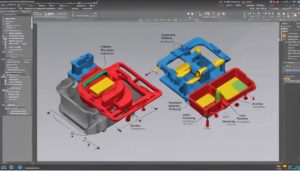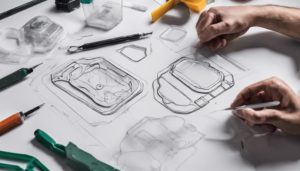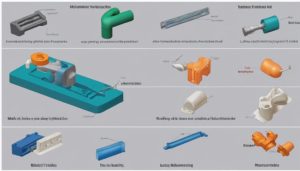Plastic injection molding involves the precise heating and injection of plastic granules into a mold cavity under high pressure. This process is ideal for thermoplastics that can be heated and cooled repeatedly without degrading. Maintaining proper mold temperature control is vital for consistent part quality. Different molding types cater to varied applications with distinct material requirements. Injection fills intricate mold details, while the cooling phase solidifies the plastic. Precision molding allows for complex shapes, controlled by parameters like temperature and pressure. For a detailed insight into the intricate workings of plastic injection molding, explore further into the process.
Plastic Injection Molding Basics
Plastic injection molding, a widely used manufacturing process in the industry, involves the precise heating and injection of plastic granules into a mold cavity using specialized equipment. This method of injection molding is particularly effective for thermoplastics, where the material can be heated and cooled multiple times without degrading.
The success of the process relies heavily on maintaining proper mold temperature control, ensuring consistent part quality. Injection pressure, typically ranging from 500 to 1500 bar, is vital for facilitating material flow within the mold cavity and achieving complete mold filling.
Different types of injection molding, such as thermoplastic, thermoset, and silicone molding, cater to a variety of applications with distinct material requirements. Understanding the nuances of material flow, mold temperature control, and the different types of molding processes is essential for producing high-quality plastic parts efficiently and accurately in the injection molding industry.
Thermoplastic Selection and Mold Preparation

Selecting the appropriate thermoplastic material is a critical aspect of the injection molding process. It impacts the final product's properties and performance. Additionally, meticulous mold surface preparation is imperative. It ensures the smooth release of the finished part and maintains the tool's longevity.
Material Selection Importance
In the domain of plastic injection molding, the meticulous selection of thermoplastics and the intricate preparation of molds play a critical role in shaping the material properties and characteristics of the final product.
- Thermoplastic Selection Importance:
- Considerations like strength, flexibility, heat resistance, and cost influence the choice.
- Determines the material properties and performance of the end product.
- Mold Preparation Significance:
- Involves creating precise cavities and cores that replicate the product design accurately.
- CAD and 3D printing technologies guarantee high precision and efficiency in mold preparation.
The right combination of thermoplastic selection and mold design is essential for successful and consistent plastic injection molding, guaranteeing the final product meets the desired specifications.
Mold Surface Preparation
The success of plastic injection molding hinges greatly on the meticulous preparation of mold surfaces, which directly impacts the adhesion and release properties essential for shaping the final product. Thermoplastic selection plays a critical role, with options like ABS, Nylons, Polycarbonate, and Polypropylene chosen for specific properties.
Mold preparation involves creating mold tools with a mold cavity and core using CAD technology and 3D printing. Mold surface preparation is a key step, including processes like polishing, texturing, and applying release agents to facilitate smooth part ejection. This careful surface preparation enhances the quality and consistency of the molded plastic components, ensuring the production of precise and high-quality parts in the injection molding process.
Feeding and Melting Process

During the feeding process, plastic pellets are introduced into the hopper and fed into the heated barrel for melting.
The heat and pressure generated by the screw mechanism gradually melt the plastic pellets into a molten state.
Subsequently, the molten plastic is injected into the mold cavity through the injection screw for the formation of the desired plastic part.
Material Feeding Process
At what stage does the plastic material undergo the important process of feeding and melting in plastic injection molding?
The material feeding process begins with plastic pellets being fed into the hopper at the top of the injection molding machine. Once inside, the thermoplastic is gradually heated within the barrel to a precise temperature, facilitated by temperature control settings. An injection screw then pushes the molten plastic through the nozzle into the mold cavity, ensuring proper material flow and mold filling.
Maintaining the correct temperatures throughout this process is essential for efficient and high-quality injection molding operations.
Heat and Melt
In the plastic injection molding process, the heat and melt phase involves the gradual transformation of plastic pellets into molten form within the heated barrel of the machine. Plastic pellets are fed into the hopper of the injection molding machine for the feeding process.
The rotating screw inside the barrel gradually melts the plastic pellets, ensuring precise temperatures are maintained for efficient injection molding. This process is essential as the molten plastic is then ready to be injected into the mold cavity for shaping.
Proper feeding and melting of the thermoplastic material are fundamental steps in the injection molding process, ensuring the production of high-quality plastic parts.
Injection Into Mold
The initial phase of the plastic injection molding process involves feeding plastic granules into the machine's hopper for subsequent heating, melting, and injection into the mold cavity under controlled conditions.
- Plastic granules are gradually heated and melted inside the machine's heated barrel using a rotating screw.
- The molten plastic is then injected into the mold cavity under pressure for efficient shaping.
- Proper temperature control is crucial to guarantee the molten plastic flows smoothly and fills the mold completely.
- This precise injection molding process allows for the creation of complex plastic components with consistent quality.
Injection Into Mold Cavity

Injection into the mold cavity is a pivotal step in the plastic injection molding process, where molten plastic is introduced under high pressure to shape the desired product.
The molten plastic is injected into the mold cavity to fill the intricate contours and details of the mold. This process is carefully controlled using the gate, which regulates the flow of plastic into the mold cavity.
High pressure is applied during injection to guarantee that the molten plastic completely fills the mold cavity, preventing any voids or defects in the final product.
Once the mold cavity is filled, the plastic is left to cool and solidify within the mold, taking on the desired shape. The cooling phase is vital as it determines the final part's dimensions and properties.
After cooling, the ejection system is activated to remove the solidified plastic part from the mold cavity, allowing for further processing or finishing touches.
Holding and Cooling Phase

During the holding phase in plastic injection molding, pressure is maintained in the mold to guarantee proper packing and material distribution, essential for component integrity.
The duration of the holding phase is determined by the thermoplastic type, vital for preventing voids or air pockets.
Subsequently, as the screw retracts, the cooling phase commences, allowing the plastic to solidify within the mold, a critical step for achieving consistent and high-quality plastic components.
Mold Temperature Control
Maintaining precise mold temperature control is a critical factor in ensuring the uniform quality and dimensional accuracy of plastic parts during the holding and cooling phases of injection molding.
- Proper mold temperature control during the holding phase is essential for achieving uniform part quality.
- Maintaining the correct mold temperature helps prevent warpage and shrinkage in the injected plastic.
- The cooling time in injection molding allows the plastic to solidify accurately according to the mold's shape.
- Controlling the cooling time is vital to avoid defects such as sink marks and internal stresses in the final part.
Material Solidification Process
Proper control of the material solidification process, specifically during the holding and cooling phases, is paramount in ensuring the production of high-quality and dimensionally accurate plastic components in injection molding.
During the holding phase, the molten plastic is pressurized to pack the mold cavity adequately. The duration of the holding time is determined by the thermoplastic type and part complexity to prevent defects such as sink marks, warpage, or incomplete mold filling.
Subsequently, as the screw retracts, the cooling time commences, allowing the plastic to solidify within the mold. Effective management of holding and cooling times is essential for achieving the desired high-quality standards in plastic injection molding.
Cooling Time Optimization
Optimizing the cooling time during the holding and cooling phase is crucial for ensuring the proper solidification of plastic material within the mold in injection molding processes.
- Adjusting holding time based on thermoplastic properties guarantees the plastic is packed effectively in the mold.
- Determining cooling time ranges according to specific thermoplastic properties is essential for proper solidification.
- Efficient ejection and cooling processes are key for cycle time optimization in injection molding.
- Proper mold packing and cooling phase contribute significantly to achieving high-quality plastic parts and reducing production cycle times.
Ejection and Finishing Steps

Upon completion of the molding process, ejection pins or plates are utilized to extract the molded parts from the mold cavity. The molded parts are then typically collected in a compartment or on a conveyor belt for further processing. This stage involves various finishing processes to enhance the appearance and functionality of the components. Finishing processes may include polishing, dying, or any other surface treatment deemed necessary. Additionally, excess plastic, such as spurs or flash, is trimmed or removed to guarantee the parts meet the required specifications.
| Ejection and Finishing Steps | |
|---|---|
| Process | Description |
| Ejection | Utilization of ejection pins or plates to remove molded parts from the injection mold cavity. |
| Collection | Gathering of molded parts in a designated compartment or on a conveyor belt for further processing. |
| Finishing Processes | Additional treatments like polishing, dying, or other methods to enhance the appearance and functionality of the molded parts. |
| Trimming | Removal of excess plastic material, such as spurs or flash, to ensure the final components meet quality standards and specifications. |
Precision and Complexity in Molding

Achieving exceptional precision and replicating intricate complexities are fundamental aspects of the plastic injection molding process.
- High-Quality Results: Precision in plastic injection molding guarantees that parts are manufactured with small tolerances, leading to high-quality final products.
- Accurate Replication: Complex geometrical shapes and features can be precisely replicated through the molding process, showcasing the accuracy of this manufacturing method.
- Controlled Parameters: Tight control over parameters such as temperature, pressure, and cooling time is crucial in achieving precise and consistent results in plastic injection molding.
- Intricate Details: Molds can be designed with intricate details and fine features, highlighting the level of complexity that injection molding can achieve.
Injection molding's ability to produce intricate and detailed components with high precision makes it a versatile manufacturing process for a wide range of industries.
The meticulous attention to detail, coupled with advanced technologies and tools, enables the creation of intricate parts that meet the most stringent quality standards.
Cost-Effective Mass Production

Plastic injection molding facilitates efficient mass production of identical components through a streamlined manufacturing process that optimizes cost-effectiveness. By leveraging the benefits of this technique, manufacturers can greatly reduce labor costs and cycle times when compared to alternative manufacturing methods. The ability of injection molding to accommodate high production volumes leads to economies of scale, allowing for lower per-unit costs as production quantities increase. One key factor contributing to the cost-effectiveness of plastic injection molding is the amortization of tooling costs over large production runs, spreading out this initial investment and reducing the overall cost per part.
Furthermore, by streamlining production processes through injection molding, manufacturers can achieve additional cost savings. The efficiency and precision of this method ensure that each part meets the required specifications consistently, minimizing waste and rework. Overall, the cost-effective nature of plastic injection molding makes it an appealing option for mass-producing components in various industries.
High-Pressure Injection Process

A critical aspect of the plastic injection molding process involves the precise application of high-pressure injection, typically ranging from 500 to 1500 bar, to facilitate ideal material flow into the mold cavity. This high-pressure injection is essential for ensuring that the molten material fills the mold cavities completely and uniformly, resulting in high-quality final products.
Here are four key factors related to the high-pressure injection process:
- Maintaining Mold Temperature Control: Precise control of the mold temperature is important to prevent issues such as warping, shrinkage, or incomplete filling of the mold cavities.
- Nozzle Pressure: Proper control of the nozzle pressure is crucial for achieving consistent and accurate material injection, ensuring that the material reaches all parts of the mold cavity effectively.
- Recovery Rate Optimization: Optimizing the recovery rate helps in improving production efficiency by reducing cycle times and maximizing the output of quality parts.
- Clamping Force: Adequate clamping force is necessary to hold the mold closed during the injection process, ensuring the structural integrity of the mold and preventing material leakage.
Custom Mold Cavity Shaping

Custom mold cavity shaping in plastic injection molding involves the intricate design and fabrication of the internal mold cavity to correspond precisely with the desired geometry of the final plastic component. This process is vital for ensuring precision, accuracy, and the replication of complex geometries in the manufactured parts. By utilizing techniques such as CNC machining or Electrical Discharge Machining (EDM), manufacturers can achieve the necessary intricacies in mold cavity shaping to produce components with consistent part quality and dimensional accuracy.
In custom mold cavity shaping, features like cores, inserts, slides, and lifters are incorporated to enable the creation of intricate designs and undercuts within the molded parts. The use of advanced CAD/CAM software further enhances the optimization of cavity design, leading to improved production efficiency and reduced material waste. By prioritizing precision and accuracy in mold cavity shaping, manufacturers can uphold high standards of quality while minimizing the environmental impact associated with excess material usage.
Frequently Asked Questions
How Does Injection Molding Work Step by Step?
Injection molding works step by step by melting plastic pellets, injecting the molten plastic into a mold cavity, and allowing it to cool and solidify. This process necessitates precise control of parameters like temperature, pressure, and cooling time to guarantee high-quality parts.
Injection molding machines, powered by hydraulic or electric mechanisms, utilize a screw mechanism to melt and inject the plastic. Pressure is applied to fill the mold cavity, followed by a cooling phase before ejecting the finished part.
What Is the Mechanism of Plastic Injection Molding?
The mechanism of plastic injection molding involves the precise injection of molten plastic material into a mold cavity at high pressure. This process allows the material to take the desired shape within the mold.
Once injected, the plastic cools and solidifies, forming the final product. Control over parameters such as injection pressure, mold temperature, and clamping force is crucial to guarantee the quality and consistency of the molded components.
What Are the Basics of Plastic Injection Molding?
Plastic injection molding is a widely used manufacturing process that requires meticulous attention to detail. The basics involve melting plastic resin pellets and injecting them into a mold cavity. Control of temperature, pressure, and cooling is essential for precision and consistency. Mold tools, often made from steel or aluminum, shape the final product.
Quality control systems are essential for reliability and repeatability in this efficient method of producing intricate parts.
How Is Plastic Injection Molded?
Plastic injection molding is achieved by injecting molten plastic into a mold cavity under pressure. The plastic cools and solidifies in the mold, taking the shape of the desired part.
This process allows for the production of intricate and precise parts with high repeatability. Injection molding is favored for its efficiency, cost-effectiveness, and ability to create identical parts.
Its versatility makes it a widely used manufacturing method across various industries.
Conclusion
To sum up, plastic injection molding is a highly efficient and precise manufacturing process that allows for cost-effective mass production of complex and intricate parts.
The high-pressure injection process, combined with custom mold cavity shaping, guarantees the creation of precision components with minimal waste.
This method offers a multitude of benefits, including versatility in thermoplastic selection and mold preparation.
Overall, plastic injection molding stands as a powerful production process, providing precision, complexity, and cost-effectiveness.







